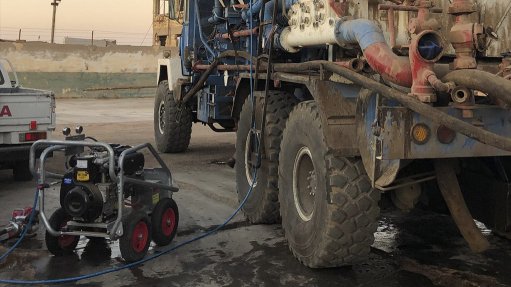
HYDROSTATIC RANGE Aussie Mine Boss hydrostatic testers are vital for verifying the integrity of water, as well as gas and oil pipelines
Pumps manufacturer and supplier Australian Pumps Industries has a prominent presence in the Australian mining industry, particularly with 6-inch pumps in diversified miner Rio Tinto’s Dampier Salt operations, in Perth, Australia, as well as large trash pumps operating in gold and copper mines in the country.
“As an example, Australian Pumps are the official distributor of submersible pumps manufacturer Tsurumi’s pumps. Tsurumi’s pumps are finding a home in coal and iron-ore production in Australia. Both high head and submersible slurry pumps are also proving to be quite popular,” enthuses Australian Pumps MD Warwick Lorenz.
He adds that Tsurumi pumps supplied by Australian pumps are being used at Australian mining and agriculture company Hancock Prospecting’s Roy Hill mine, in Western Australia’s Pilbara region.
“We have Aussie Mine Boss, Tsurumi submersibles and our own Mine Boss pressure cleaners virtually on every mining site in Australia and through the South Pacific. Our products are found in Papua New Guinea, New Caledonia and even New Zealand,” Lorenz points out.
While the company’s products are used in a range of applications at opencast mines and quarries across South America, Europe, Africa and India, Lorenz emphasises that lithium and copper production in Australia provides an ideal opportunity for the company to grow more into the mining industry – particularly in terms of its large pressure cleaners.
“Australia is the seventh-largest copper producer in the world. The benefit of this commodity is that it is 100% recyclable – 80% of the copper that has ever been produced is still in use today,” he comments.
Lorenz states that the country’s copper production should rise to about 941 000 t/y to more than one-million tonnes a year in 2020/21.
“Much of this increase will be driven by global resources company BHP’s Olympic Dam, in South Australia, as well as the startup of copper miner OZ Minerals’ Carrapateena mine. South Australia looks set for a huge boost, as Carrapateena’s yearly production is expected to contribute significantly,” he suggests.
Lorenz describes the Australian mining industry as resurgent, with much development work occurring. Australian research organisation the Australian Bureau of Agricultural and Resources Economics and Sciences forecasts income earned from exports in the resource and energy sectors to increase from A$225-billion in 2018/19 to A$285-billion in 2019/20.
The growth of the Australian mining industry also hinges on commodity prices, based on supply and demand, with the price of metallurgical coal hovering at $200/t during the June quarter and strong iron-ore prices in 2019 providing a significant boost for two of the country’s key mining commodities, he highlights.
“When the world economy is strong and demand is up, resource-based economies can do very well. We believe that the continuing growth of the world population and the programmes to improve education and living standards provide an unstoppable force to drive the demand for energy and mineral products.”